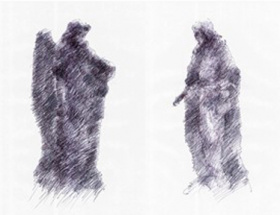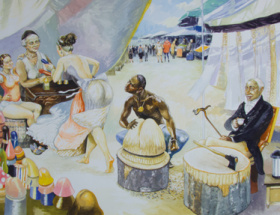Ernesto Benítez and the Need to religare
By Eduardo Albert Santos
Ernesto Benítez’s artistic production has gradually become oriented toward a particularly topical issue. In the present circumstances, the collapse of existence drawn in terms of coherence, stability, confidence in the future, leads to the image of the broken and fragmented human being, dislocated with himself and his environment, doubtful of his own subjectivity, which he fears or in which he is consumed without a pertinent way out. Of a being that does not finish composing or articulating his project, that doubts his possibilities or does not specify them adequately, that does not manage to find his authentic achievement.
In this sense, the work is generated from the uncertainty of this chaotic time, in which the evident breakdown of the hopeful meta-narratives or the multitude of divergent partial narratives do not allow the individual to be centered and make him remain in an anguished vigil without convincing solutions. Ernesto refers his universe of meaning to three lines of tension: globalization and biased identity, fragmented memory and/or hijacked spirituality. And such an arc of interests is based on his personal conflictive experience derived from his splitting, from what he calls “cultural wound”. A wound that, referring to himself, is at the same time a symptom of a time that registers a lack of safe, firm, reliable spaces of meaning and that affects all of us.
This is where a good part of the morphology of his works comes from. His skillful use of materials such as fire, salt, snails, ashes, feathers, and records of the dead; of the discarded, the fragile or the wounded; of the evicted or obsolete propaganda; of philosophical texts subjected today to questioning or scrutiny, all refer to the rhetoric of the unresolved enigma of the uncertain present. Both in his installations and photographs or videos, Ernesto appeals to the exercise of questioning daily defficiencies; he refers to the obsolescence of the domination discourse validated by the established powers and the agonizing absence of alternative stories of emergencies and sustainable renewals.
In general, Ernesto Benítez’s artistic discourse registers a very suggestive philosophical and anthropological substratum. He himself acknowledges that he tries to “search for himself” and does so not as a problematic introspection with a subjective charge, but by appealing to the experiences of his personal temporality and his environment. He first looks at the anthropological avatars in dialogue with the local imaginaries of the nineties in Cuba. Then, from his new life enclave, he expands his gaze and reflects, in a more far-reaching horizon, on more vast fields, marked by less local experience and one of greater post-metaphysical depth, projected towards what Heidegger would call “the question of the meaning of being”. For that reason, in his most recent works, he would seem to be insistently questioning himself about the Dasein, about existence as project, as reality that is not made, that is not present but looked for and constructed, and turns the world into his existence, granting it meaning with regard to our lives and our aims. And he questions how, in the present state of affairs, in midst of an existential crisis so much in lack of reliable support, one can be “‘chosen’, conquered, or lost, or not conquered at all”.
This last aspect is very well perceived in his photographic installations Filosofía I y II (Philosophy I and II) or in his Templos deshabitados (Uninhabited Temples). While in his series Taedium vitae, the vicissitudes of the exhaustion of life that accompanied Wilde in his daily tedium can be appreciated with a striking visual formulation. On the other hand, the series Lebenswelt alludes to that Husserl world’s life in which one experiences the staging of a reality where life itself is consumed in its memories and registers.
There is no pessimistic reading of the present in Benítez’s work. In midst of his sharp chronicle on the laceration of the self in this time, he pronounces himself to advance toward the “clarity of being”. And as interpreted by Gadamer, “that clarity must be produced within the human being himself”, who must recover his own light and submit to an aphaeresis that will heal him. The artist expresses this in an interview when he refers to an “irrepressible need to religare”.






